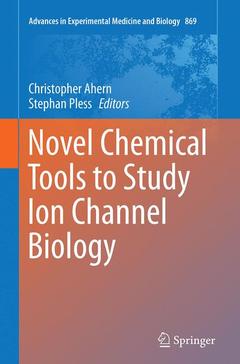Description
Novel Chemical Tools to Study Ion Channel Biology, 1st ed. 2015
Advances in Experimental Medicine and Biology Series, Vol. 869
Coordinators: Ahern Christopher, Pless Stephan
Language: English
Subjects for Novel Chemical Tools to Study Ion Channel Biology:
Keywords
Biophysics; Bioreactivity; Fluorometry; Ion Channels; Modifications; Proteins
Publication date: 10-2016
Support: Print on demand
Publication date: 09-2015
154 p. · 15.5x23.5 cm · Hardback
Description
/li>Contents
/li>Biography
/li>Comment
/li>
This volume describes chemical approaches to assess ion channel structure, function and pharmacology. Topics discussed include the use of engineered ionizable side chains to obtain information on permeation pathways and the local environment; the modification of engineered cysteine side chains, including cysteine scanning mutagenesis and the attachment of fluorescent probes and bio-reactive tethers; and the nascent use of genetic code expansion, evaluating its applications to ion channel and membrane proteins. This comprehensive text provides multifaceted perspectives on the great diversity of state-of-the-art methods which take advantage of the ever-expanding chemical toolbox to study ion channel biology.
Capturing the contributions and innovations of renowned laboratory researchers in transmembrane protein study for the first time, this book is comprehensive in scope. It covers a wide array of experimental approaches: photochemistry, novel biological tools, and innovative spectroscopy, all combined with traditional techniques of electrophysiology and molecular biology. Novel Chemical Tools to Study Ion Channel Biology, part of the bestselling Advances in Experimental Medicine and Biology series is ideal for researchers and advanced students interested in biochemistry, biophysics, fluorometry, electrophysiology, and chemical biology.
.?Christopher Ahern, PhD, is currently an Associate Professor in the Department of Molecular Physiology and Biophysics at the University of Iowa. Dr. Ahern received his BS in Chemistry and PhD in Physiology at the University of Wisconsin-Madison. He began working with genetic code expansion approaches during his post-doctoral studies with Dr. Richard Horn at Jefferson Medical College along with Drs. Henry Lester and Dennis Dougherty at the California Institute of Technology. Dr. Ahern’s research laboratory has expressed a variety of channels with synthetic amino acids of their own design, and is developing new protocols to facilitate their expression in complex cell types.
Stephan A. Pless is an Associate Professor in the Center for Biopharmaceuticals, Department of Drug Design and Pharmacology, at the University of Copenhagen in Denmark. Dr. Pless completed his undergraduate degree in biochemistry and molecular biology at the University of Hamburg in Germany. He then obtained a PhD in molecular neuroscience with Dr. J. Lynch at the University of Queensland in Australia, before pursuing his postdoctoral studies with Drs. C. Ahern and H. Kurata at the University of British Columbia in Canada. Dr. Pless´ current research focuses on using a combination of electrophysiology, spectroscopy and synthetic amino acids to understand the molecular function and pharmacology of ligand-gated ion channels.
These books may interest you

Ion Channels and Their Inhibitors 105.49 €



